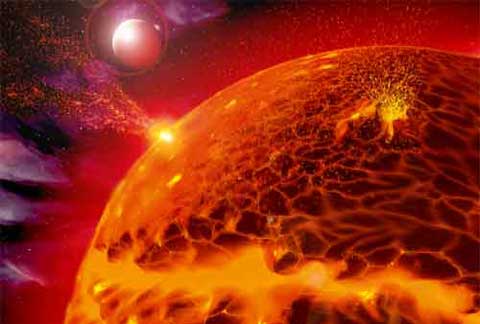During the centuries when Venus was a comet, it had a tail. What could give Venus the appearance of a star throwing out smoke?
2005 10 30
From: crystallotus.com

The Vedas said that the star Venus looks like fire with smoke. The star had a tail, dark in the daytime and luminous at night. This luminous tail, which Venus had in earlier centuries, is mentioned in the Talmud `Fire as hanging down from the planet Venus. Described by the Chaldeans the planet Venus `was said to have a beard. "Beard" is used in modern astronomy in the description of comets.
The Mexicans called a comet `a star that smoked. What was the illusion of the ancient Toltecs and Mayas? What was the phenomenon and what was its cause? A train, large enough to be visible from the earth and giving the impression of smoke and fire, hung from the planet Venus. Venus, with its glowing train, was a very brilliant body; therefore not strange that the Chaldeans described it as a `bright torch of heaven. Illuminates like the sun,' and compared with the light of the rising sun.
At present, the light of Venus is less than one millionth of the light of the sun. `A stupendous prodigy in the sky,' the Chaldeans called it. The Hebrews similarly described the planet: `The brilliant light of Venus blazes from one end of the cosmos to the other end . The Chinese astronomical text refers to the past when `Venus was visible in full daylight and, while moving across the sky, rivalled the sun in brightness.
Venus (Ishtar) `who is clothed with fire and bears aloft a crown of awful splendour.' The Egyptians described Venus (Sekhmet) : `A circling star which scatters its fame in fire . . . a flame of fire in her tempest.' They also called it by the name of Twntemocque, or `the mane.' The Arabs called Ishtar (Venus) by the name Zebbaj or `one with hair,' as did the Babylonians
`Sometimes there are hairs attached to the planets,' wrote Pliny. Hair or coma is a characteristic of comets, and in fact `comet' is derived from the Greek word for `hair.' The Peruvian name 'Chaska' (wavy-haired). is still the name for Venus, though at present the Morning Star is definitely a planet and has no tail attached to it.
The coma of Venus changed its form with the position of the planet. When the planet Venus approaches the earth now, it is only partly illuminated, a portion of the disc being in shadow; it has phases like the moon. At this time, being closer to the earth, it is most brilliant. When Venus had a coma, the horns of its crescent must have been extended by the illuminated portions of the coma. It had two long appendages and looked like a bull's head.
Rabbinical authorities say that `the devotion of Israel to this worship of the bull is in part explained by the circumstance that, while passing through the Red Sea, they beheld the celestial Throne, and most distinctly of the four creatures about the Throne, they saw the ox.
The Egyptians similarly, pictured the planet and worshipped it in the effigy of a bull. The cult of a bull sprang up also in Mycenaean Greece. A' golden cow head with a star on its brow was found in Mycenae, on the Greek mainland. The people of far away Samoa, primitive tribes that depend on oral tradition as they have no art of writing, repeat to this day: `The planet Venus became wild and horns grew out of her head.''
The long horns of Venus could have been seen without the aid of a telescopic lens. These horns were illuminated portions of the coma of Venus, which stretched towards the earth. These horns could also have extended towards the sun as Venus approached the solar orb, since comets were repeatedly observed with projections in the direction of the sun, while the tails of the comets are regularly directed away from the sun. When Venus approached close to one of the planets, its horns grew longer: this is the phenomenon the astrologers of Babylon observed and described when Venus neared Mars.
Articles from: http://www.crystallotus.com/TheTransition/024.htm
Related: Velikovsky, Mars and Venus
Velikovsky's Ghost Returns
The Birth of Venus
Venus in the Corner Pocket
Venus the two faced goddess
Venus and the pentagram
The pentagram - the pattern of Venus
Venus Morning Star, Venus Evening Star
The Tail of the Dragon
Why The Electric Universe Matters
The Sirius Mystery, the Supreme Council 33rd Degree, and the Great White Lodge of Freemasonry
The Son of the Sun - Sun & Man
Venus (wikipedia)
Venus - mythology (wikipedia)
Pentagram (wikipedia)
